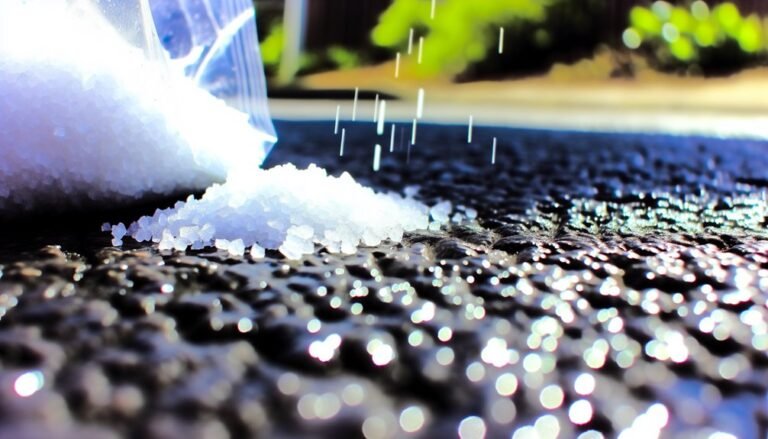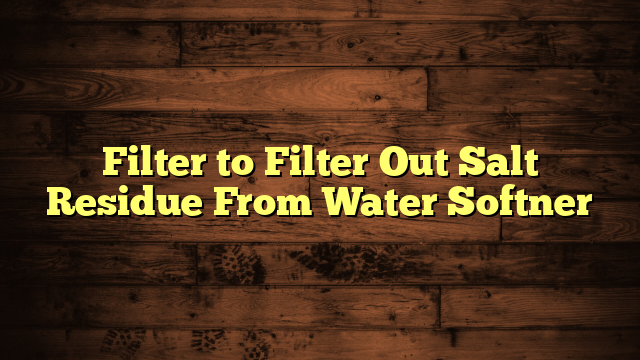Why Is My Water Softner Full of Water?
If your water softener's full of water, it could be a sign of several underlying issues. You might want to consider the possibility of a malfunctioning float valve, which can lead to excess water accumulation. Alternatively, problems with the brine draw process or a clogged drain line could also be to blame. Understanding these factors is crucial for maintaining your system's efficiency, but how do you identify the exact cause? Let's explore the potential culprits and what you can do about them.
Key Takeaways
- High water levels may indicate a malfunctioning float switch or issues with brine draw, preventing proper water level regulation.
- A stuck or broken float valve can cause continuous water flow, leading to excessive accumulation in the brine tank.
- If the drain line is clogged, it can cause back pressure, resulting in water overflow during regeneration cycles.
- Incorrect regeneration settings or malfunctioning timers may lead to excess water buildup in the softener.
- Regular inspections and maintenance of the float valve, drain line, and regeneration settings can prevent issues related to high water levels.
Normal Water Levels
Understanding normal water levels in your water softener is crucial for maintaining its efficiency. When your system operates correctly, the water levels should be just right—not too high and not too low.
Ideally, during normal operation, the water softener should have a few inches of water in the brine tank. This water is essential for dissolving the salt, creating brine that replenishes the resin beads used for softening water.
If the water levels are too low, the system might struggle to generate enough brine, leading to poor performance and hard water issues. On the other hand, excessively high water levels can indicate problems, such as a malfunctioning float switch or an issue with the brine draw.
Regularly checking the water levels can help you catch these issues early, ensuring your water softener runs smoothly. Make it a habit to inspect the brine tank; it'll give you peace of mind knowing your system is operating as it should.
Keeping track of these levels won't only enhance your water softener's efficiency but also extend its lifespan, saving you money in the long run.
Salt Bridge Issues
If you notice your water softener is full of water, a salt bridge might be forming.
This issue occurs when salt hardens and creates a barrier, preventing it from dissolving properly.
Keep an eye out for signs like a low salt level or a crusty layer on top of the salt.
Causes of Salt Bridges
One common issue that can lead to a water softener being full of water is the formation of salt bridges. A salt bridge occurs when salt crystals form a hard layer above the salt in the brine tank, creating a gap between the salt and the water below. This can happen due to a few reasons.
First, if you're using poor-quality salt, it may not dissolve properly, leading to salt buildup. Additionally, changes in temperature or humidity can also cause the salt to clump together, forming a solid bridge instead of dissolving in the water.
To avoid this problem, ensure you're using high-quality salt designed for water softeners. Regularly inspect your brine tank and break up any clumps you see.
It's also essential to keep the tank clean and free from debris. Implementing bridge prevention measures, like maintaining consistent humidity levels and adding salt regularly, can significantly reduce the chances of a salt bridge forming.
Signs of a Bridge
A salt bridge can cause several noticeable signs that indicate a problem with your water softener. One of the first signs you might notice is a decrease in water softness. If your water feels hard, it's a clear signal that something's wrong.
You may also see a layer of salt forming above the water level in the brine tank, which often means a bridge has formed beneath that layer.
Another sign of a salt bridge is the presence of a crusty or solid mass of salt, which can be mistaken for regular salt. If you experience a longer-than-usual time between regenerations, that's another potential indicator.
For effective bridge detection, you should regularly check the brine tank for odd formations or inconsistencies in salt levels.
To ensure bridge prevention, it's essential to maintain your water softener by monitoring salt levels and occasionally breaking up any clumps. Performing routine maintenance will help keep your system running smoothly and prevent costly repairs down the line.
If you suspect a salt bridge, don't hesitate to investigate further to protect your water softener's efficiency.
Clogged Drain Line
If your water softener is full of water, a clogged drain line might be the culprit.
This blockage can stem from debris buildup or improper installation, affecting the system's efficiency.
Addressing these issues promptly can help restore your water softener's functionality.
Drain Line Blockage
Many homeowners overlook the drain line when troubleshooting a water softener full of water. A blockage in this line can prevent proper water flow, leading to the softener filling up. When the drain line gets clogged, it can cause back pressure, making it difficult for the system to expel excess water during regeneration cycles.
To avoid this issue, regular drain maintenance is essential. Inspect the drain line for any visible obstructions, like dirt or debris, and clear them promptly. If the line is long or has bends, consider flushing it periodically to ensure nothing is stuck inside.
You might also want to check for kinks or sharp turns that could restrict water flow. If you suspect a blockage but can't locate it, you may need to use a plumbing snake or a wet/dry vacuum to dislodge any stubborn clogs.
Keeping the drain line clear is crucial for your water softener's efficiency and longevity. By taking these simple steps, you can prevent water overflow and ensure your unit operates smoothly. Don't let a clogged drain line become a costly headache!
Improper Installation Issues
Improper installation can lead to significant issues with your water softener, particularly when it comes to the drain line. If the drain line isn't installed correctly, it can become clogged, causing water to back up and fill the tank. This situation often stems from common installation challenges or plumbing errors.
Here's a quick look at some typical installation mistakes that can affect your water softener's drain line:
| Issue | Impact | Solution |
|---|---|---|
| Incorrect slope of drain line | Water doesn't flow properly | Adjust the angle to allow drainage |
| Kinks in the hose | Blocks water flow | Replace or reposition the hose |
| Wrong drain line size | Inadequate drainage capacity | Use the correct diameter hose |
| Poor connection to drain | Leaks or blockages | Ensure a secure and proper fit |
Addressing these installation challenges is crucial for your water softener to function efficiently. If you suspect plumbing errors, consider consulting a professional to avoid further complications. By ensuring proper installation, you can prevent water buildup and keep your system running smoothly.
Malfunctioning Float Valve
A malfunctioning float valve can lead to your water softener filling up with water unnecessarily. When this valve isn't working properly, it can't control the water level as it should. You may notice that your softener is constantly full, which can indicate issues with the float valve itself.
Here are a few signs you might need to address the float valve:
- Constantly Running Water: If you hear water running continuously, the float valve might be stuck or broken.
- Water Overflow: If water is spilling out of the softener, the float valve isn't shutting off properly.
- Low Water Levels: If the water level is too low, the float valve adjustment may be needed to ensure it operates within the correct range.
To resolve these issues, you might need to perform a float valve adjustment or, in some cases, consider a float valve replacement.
Checking the valve regularly can help prevent water from accumulating unnecessarily in your softener, ensuring it runs efficiently and effectively.
Don't wait too long; tackling these problems early can save you time and money!
Resin Tank Problems
If the float valve isn't the culprit, resin tank problems could be the reason your water softener is full of water. The resin inside the tank is crucial for softening your water, and if it's damaged, it can lead to excess water accumulation.
Resin damage often occurs due to improper maintenance or exposure to harsh chemicals, which can compromise its effectiveness.
When you notice your water softener is full, it's essential to check the resin. A clogged or damaged resin bed may prevent the proper flow of water, causing it to back up into the tank. In such cases, resin cleaning is vital.
Regularly cleaning the resin helps maintain its performance and prolongs its lifespan. To clean the resin, you'll want to follow the manufacturer's guidelines, which usually involve a specialized resin cleaner.
If the resin appears heavily damaged, you might need to replace it altogether. Addressing these resin tank problems promptly can save you from more significant issues down the line.
Improper Regeneration Cycle
When your water softener doesn't regenerate properly, it can lead to an overflow of water in the tank. If you're noticing this issue, it might be due to improper regeneration cycles.
Here are a few reasons this could be happening:
- Incorrect Regeneration Frequency: If your unit isn't set to regenerate often enough, it can become overwhelmed with hardness minerals, leading to excess water buildup.
- Faulty Regeneration Settings: Check your settings to ensure they match your water usage. If they're too low, the system won't regenerate adequately, causing water to back up.
- Timer Issues: If your softener uses a timer for regeneration, a malfunctioning timer may not trigger the cycle at the right intervals, resulting in stagnation of water.
To fix these problems, regularly review your water softener's regeneration frequency and settings.
You can often adjust these based on your household's water consumption. Making sure these elements are correct will help maintain your water softener's efficiency and prevent future overflow issues.
Maintenance Tips
To keep your water softener running smoothly, regular maintenance is essential. Start with routine checks to ensure everything's functioning properly.
Examine the brine tank for salt levels and keep it filled to the recommended level. If you notice a significant amount of water in the tank, it could indicate an issue with the float or a blockage that needs addressing.
Next, don't forget about filter replacement. Depending on your water quality, you should change your filters every 6 to 12 months. A clogged or dirty filter can lead to inefficiencies and even cause your softener to become full of water.
It's also a good idea to inspect the resin beads inside the tank. If they appear discolored or damaged, consider replacing them to maintain optimal performance.
Additionally, check the water connections for leaks and tighten any loose fittings.
Lastly, keep a maintenance log. This helps you track your checks and replacements, ensuring you stay on top of your water softener's care.
Frequently Asked Questions
Can I Manually Drain My Water Softener Tank?
Yes, you can manually drain your water softener tank. For effective tank maintenance, locate the drain valve and open it, allowing water to flow out. Just remember to close it securely afterward to prevent leaks.
How Often Should I Check My Water Softener?
You should check your water softener at least once a month. Routine inspections help ensure optimal performance and identify maintenance needs early, keeping your system efficient and prolonging its lifespan. Consistency is key for effective water softener maintenance.
What Signs Indicate a Salt Bridge Is Forming?
When you notice crusty formations on the salt, water levels rising, or reduced water softening efficiency, those are salt bridge signs. Use troubleshooting tips like tapping the tank to help break it up effectively.
Are There Specific Brands More Prone to Water Retention Issues?
When considering brand comparisons, some water softener brands are indeed more prone to water retention issues. Regular maintenance tips, like checking salt levels and cleaning, can help prevent these problems regardless of the brand you choose.
Can Hard Water Damage My Water Softener?
Yes, hard water can damage your water softener. Its effects lead to mineral buildup, reducing efficiency. Regular water softener maintenance, including cleaning and resin replacement, helps prevent these issues and prolongs your system's lifespan.
Conclusion
If your water softener is full of water, it's crucial to address the issue promptly. Check for common problems like a malfunctioning float valve, a clogged drain line, or salt bridge issues. Regular maintenance can prevent these headaches and keep your system running smoothly. By staying proactive, you'll ensure your water softener works efficiently, providing you with the soft water you need. Don't let a full tank disrupt your home's water quality—take action today!







